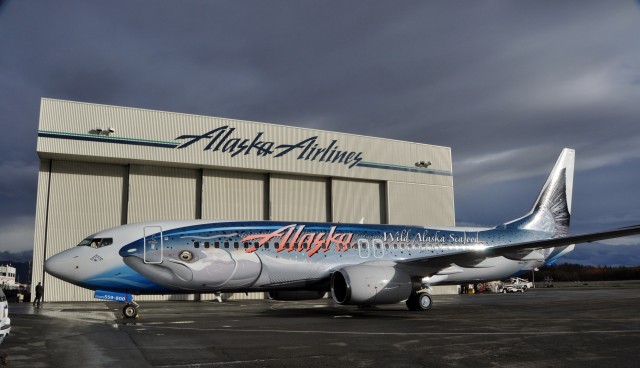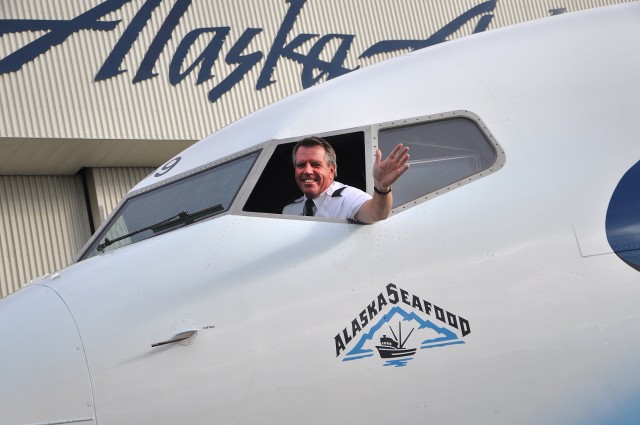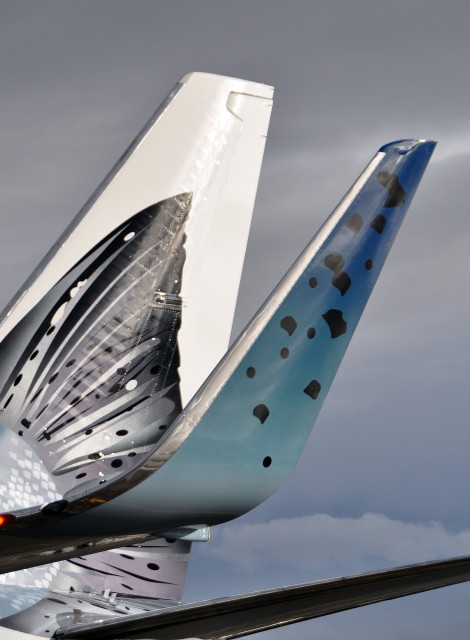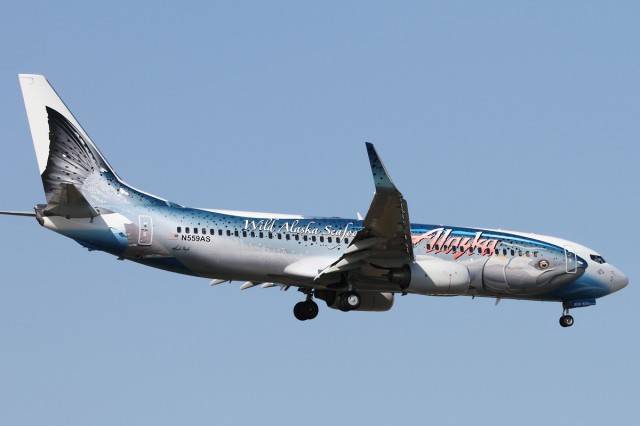
The new Salmon-Thirty-Salmon livery shown off in Anchorage. Image from Alaska Airlines. CLICK FOR LARGER.
One of the best liveries out there was Alaska Airline’s original Salmon-Thirty-Salmon livery on a Boeing 737-400. The airline re-painted the old salmon livery a while back and many have missed it (including me). Have no fear – a new salmon livery is here. This week, Alaska unveiled their Salmon-Thirty-Salmon II livery in Anchorage and it is even better than the first.
This time, a Boeing 737-800 was used as a larger canvas. The fish-plane comes in at 91,000 pounds and measures at almost 129 feet. Alaska calls this “the most intricately painted commercial aircraft in the world.”
There are not too many differences between the older salmon livery and the newer one. The concept remained the same; to paint a huge salmon on a plane. One of the biggest changes is the fact that the 737-800 has winglets with scales. Also the “Alaska” name is painted in a salmon color versus white of the previous design.

How could you not smile flying such a beautiful plane? Image from Alaska Airlines. CLICK FOR LARGER.
The design used four gallons of Mylar paint to create an iridescent sparkle over the nearly 3500 fish scales. Crews worked 27 days straight in Oklahoma City and used 21 unique colors to get this amazing livery completed.
“Today, we are proud to introduce the largest flying fish to all of Alaska and the world,” said Marilyn Romano, Alaska Airlines’ regional vice president of the state of Alaska. “Not only will this special plane spotlight the best, most sustainable seafood harvest in the world, it will also remind us of the important role the seafood industry has on the Alaska economy. On behalf of the 1,700 Alaska Airlines employees working in the state, we are also proud to safely fly the thousands of men and women who work in the seafood industry throughout the Last Frontier.”
A big thanks to Brandon for letting me share his photo of the Salmon-30-Salmon landing at Seattle-Tacoma International Airport.
The above video highlights the process of painting the Salmon-30-Salmon livery.


Easily one of the Top Five liveries I’ve ever seen. Thanks. Video is fun too; I wonder AS could be persuaded to release a longer version. It would be a fun and informative viewiewing experience.
Another great addition to the fleet.
That is so freakin cool! Where does it fly?
Beautiful job!
Alaska Airlines takes flying fish to a whole new level
$500,000 grant from federal funding pays for custom paint job on company’s passenger jet
By WESLEY LOY
Anchorage Daily News
Published: October 2, 2005
Last Modified: October 2, 2005 at 03:07 AM
http://www.adn.com/front/story/7038924p-6942571c.html
So, you landed a big king salmon this summer? It can’t compare to the colossal king Alaska Airlines plans to land this morning in Anchorage. The Seattle-based carrier has painted nearly the full length of a Boeing 737-400 passenger jet as a wild Alaska king, or chinook, salmon. The airline has dubbed its flying fish the “Salmon-Thirty-Salmon.”
It’s a bold promotional move to celebrate wild Alaska seafood and also the carrier’s role in hauling millions of pounds of fresh salmon, halibut, crab, shrimp and other seafood out of the state each year.
The fishy paint job was done on a grand scale, company spokesmen said. A team of 30 painters and airbrush artists used more than 140 gallons of paint and took 24 days to render the lifelike chinook — triple the time normally needed to coat an airliner.
A local nonprofit agency, the Alaska Fisheries Marketing Board, gave Alaska Airlines a $500,000 grant to paint the jet. The money came out of about $29 million in federal funding U.S. Sen. Ted Stevens of Alaska and his congressional colleagues have appropriated to the marketing board, created in 2003, to promote and enhance the value of Alaska seafood. The senator’s son, state Sen. Ben Stevens, is chairman of the agency’s board of directors.
Airbrush artist Chris Coakley, a worker at Goodrich Aerospace in Everett, Wash., paints an Alaska Airlines 737, now called the “Salmon-Thirty-Salmon,” to look like a giant king salmon Friday. A crew of 30 painters spent 24 days on the job.
Well Duncan,
Based on the website you have your name linked to, I am going to take a wild guess you have an agenda.
I don’t know if you know very much about Marketing. Yes, they spent more money to make the paint job and Alaska will pay more money to fly this paint job around (weight costs money). But look. I wrote a story on it and so did many other people. A normal paint job would not have received that amount of attention.
Look at the bigger picture my friend. Advertising Alaska (state, not airline) seafood, increases purchases, which increases demands for jobs. Not rocket science.
David